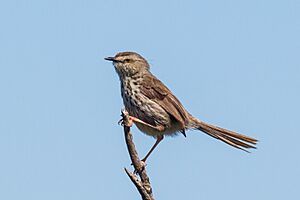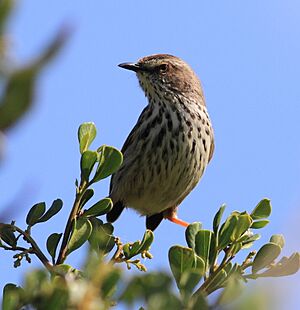Karoo prinia facts for kids
Quick facts for kids Karoo prinia |
|
|---|---|
 |
|
| Conservation status | |
| Scientific classification | |
| Genus: |
Prinia
|
| Species: |
maculosa
|
The Karoo prinia or spotted prinia (Prinia maculosa) is a small passerine bird. This means it is a type of songbird. You can find it living in South Africa, Lesotho, and the southern parts of Namibia.
These birds like to live in karoo scrub, fynbos (a type of plant area), and bracken-covered hills. They prefer semi-desert and mountain areas. There's another bird, the Drakensberg prinia, which used to be thought of as the same species.
Contents
About the Karoo Prinia's Name
The Karoo prinia got its scientific name from a few different people. A French scientist, Georges-Louis Leclerc, Comte de Buffon, first described this bird in 1779. His work was part of a big book about birds.
Later, in 1783, a Dutch scientist named Pieter Boddaert gave the bird its scientific name, Montacilla maculosa. The word maculosa comes from Latin and means "spotted," which fits this bird's look.
Today, the Karoo prinia is part of the Prinia group of birds. This group name comes from the Javanese word prinya, which is a local name for a similar bird.
Different Types of Karoo Prinia
Scientists recognize three slightly different types, or subspecies, of the Karoo prinia:
- P. m. psammophila: Found in southwest Namibia and western South Africa.
- P. m. maculosa: Lives in southern Namibia and central and southern South Africa.
- P. m. exultans: Found in southeast South Africa and Lesotho.
What Does the Karoo Prinia Look Like?
The Karoo prinia is a small bird, about 13 to 15 centimeters (5 to 6 inches) long. It has short, rounded wings and a fairly long tail. Its legs are strong, and its beak is short, straight, and black.
Its head has a whitish stripe above its eye, like an eyebrow. The rest of its upper body is brown. Its throat and lower face are whitish with dark streaks. The rest of its belly is yellowish-white or yellow with clear black streaks.
The long tail often sticks up at an angle and has a dark spot near the end. Its feet and legs are pinkish-brown, and its eyes are dark brown. Male and female Karoo prinias look the same. Young birds are much yellower underneath and have fewer streaks than adults.
Sounds and Calls
The Karoo prinia makes several sounds. You might hear a sharp chleet-chleet-chleet call. It also makes a fast, buzzing tit-tit-tit sound.
It can be hard to tell the Karoo prinia apart from the Drakensberg prinia. However, the Karoo prinia has less yellow on its belly and more spots than the Drakensberg prinia.
Life and Habits of the Karoo Prinia
The Karoo prinia builds a thin, oval-shaped nest from green grass. The nest has an entrance on the side. They hide their nests deep inside a leafy shrub or bush to keep them safe.
These birds usually breed from August to September in areas that get winter rain. In other places, they might breed later, sometimes up to December.
You will often see Karoo prinias in pairs or small groups. They usually stay low in the bushes, but sometimes they perch on top of a bush. They are very active when looking for small insects to eat. As they search, their tail is often cocked up and swings from side to side.
Is the Karoo Prinia Safe?
The Karoo prinia is a common bird with a large habitat. Its home covers an area of about 670,000 square kilometers (258,000 square miles). Scientists believe there are many of these birds.
The number of Karoo prinias is not decreasing quickly. Because of this, the IUCN Red List considers the species to be of "Least Concern." This means they are not currently at risk of disappearing.



